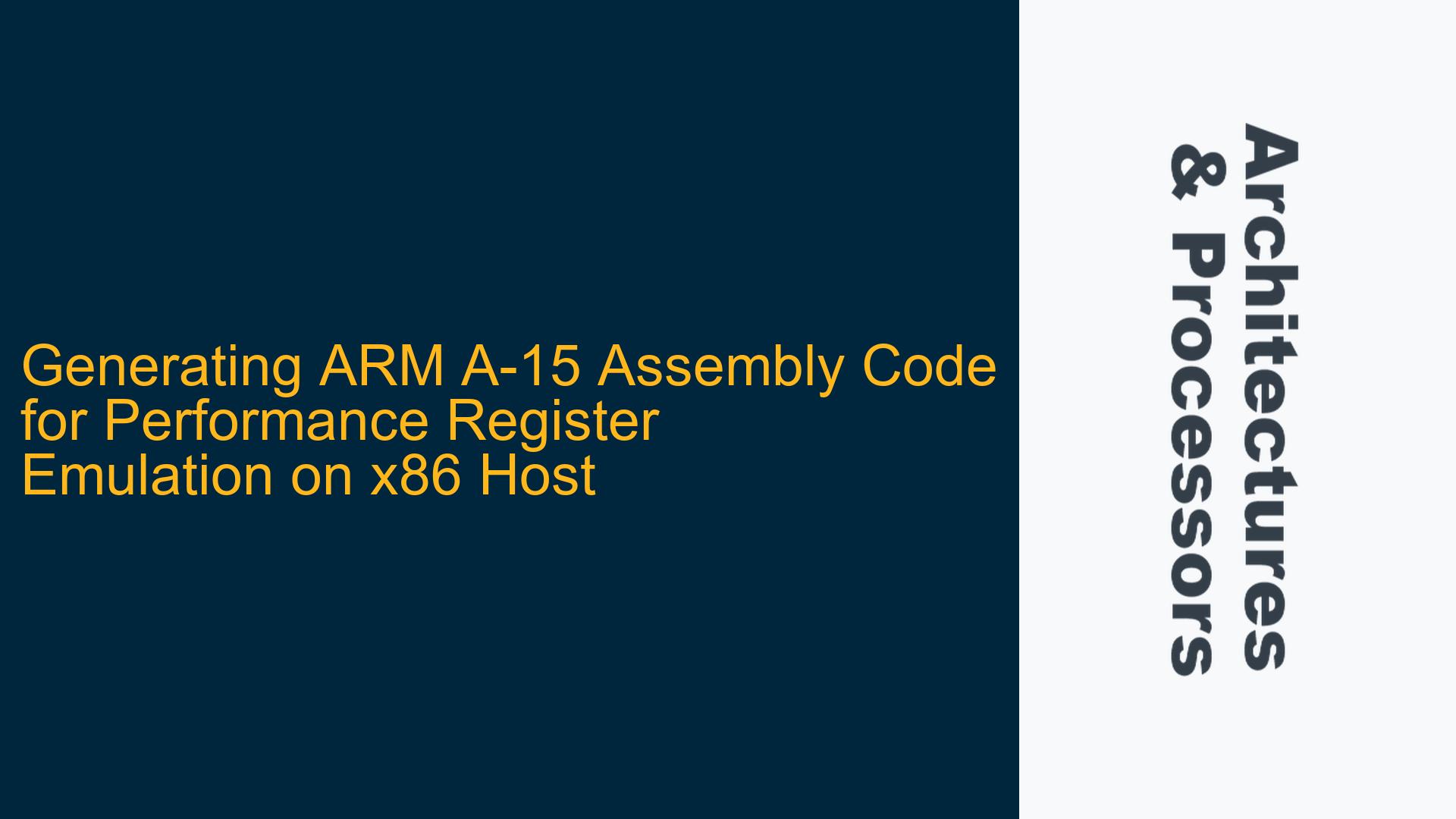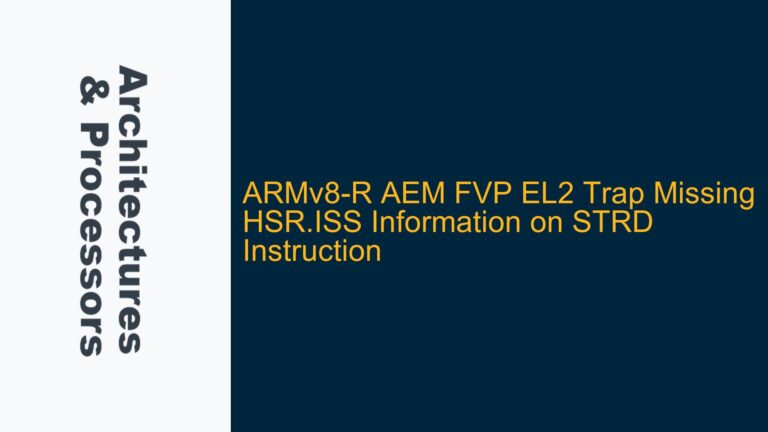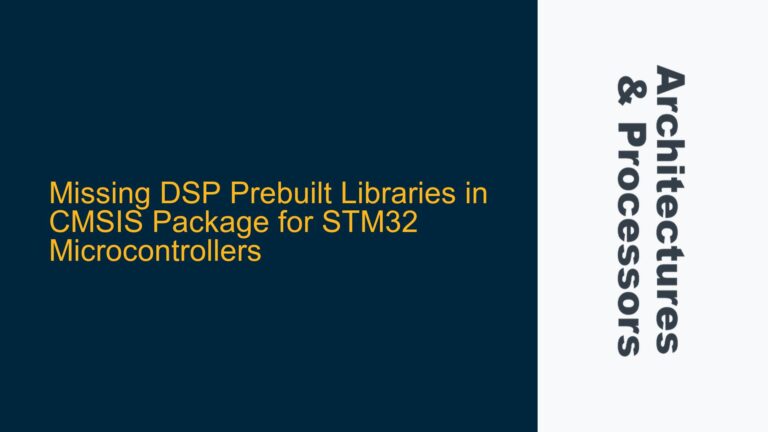ARM A-15 Performance Register Emulation Challenges on x86 Host
Emulating ARM A-15 performance registers on an x86-based system, such as an Intel i5 laptop, presents a unique set of challenges. The primary goal is to compile a C program into ARM A-15 assembly code to accurately measure performance metrics like instruction count, CPU cycles, bus cycles, and cache hits. These metrics are crucial for understanding the behavior of the ARM A-15 processor, but the task is complicated by the architectural differences between ARM and x86. The ARM A-15 is a 32-bit RISC processor, while the Intel i5 is a 64-bit CISC processor. This architectural mismatch necessitates a robust cross-compilation setup and a deep understanding of both instruction sets.
The ARM A-15 processor includes a set of performance monitoring unit (PMU) registers that can be programmed to count specific events. These events include the number of instructions executed, cycles taken, and cache hits/misses. However, accessing these registers directly from an x86 host is not feasible due to the lack of equivalent hardware. Therefore, the task requires generating ARM A-15 assembly code from a C program, which can then be analyzed to estimate the performance metrics.
The first challenge is setting up a cross-compilation environment that can generate ARM A-15 assembly code on an x86 host. This involves installing the appropriate toolchain, such as the GNU Compiler Collection (GCC) with ARM support, and configuring it to target the ARM A-15 architecture. The second challenge is understanding the ARM A-15 instruction set and how it maps to the performance metrics of interest. This requires a detailed analysis of the ARM A-15 PMU registers and the events they can count.
Cross-Compilation Toolchain Setup and ARM A-15 Instruction Set Mismatch
The core issue stems from the need to generate ARM A-15 assembly code on an x86 host. This requires a cross-compilation toolchain that can translate C code into ARM A-15 instructions. The GNU Compiler Collection (GCC) is a popular choice for this task, as it supports multiple architectures, including ARM. However, setting up the toolchain correctly is non-trivial, especially for beginners.
The first step is to install the ARM cross-compiler. On a Linux system, this can typically be done using the package manager. For example, on Ubuntu, the command sudo apt-get install gcc-arm-linux-gnueabihf will install the ARM cross-compiler. Once installed, the cross-compiler can be invoked using the arm-linux-gnueabihf-gcc command. This compiler will generate ARM A-15 assembly code when provided with the appropriate flags.
The next step is to understand the ARM A-15 instruction set and how it differs from the x86 instruction set. The ARM A-15 is a RISC processor, which means it has a smaller set of instructions compared to the CISC-based x86 architecture. This difference can lead to challenges when translating C code into ARM assembly, as some x86 instructions may not have direct equivalents in the ARM instruction set. For example, the x86 MOV instruction is used for both memory and register transfers, while the ARM A-15 has separate instructions for these operations (LDR for memory loads and MOV for register transfers).
Another challenge is the handling of performance monitoring unit (PMU) registers. The ARM A-15 PMU registers are used to count specific events, such as the number of instructions executed or cache hits. These registers are not present in the x86 architecture, so they must be emulated in software. This requires a detailed understanding of the ARM A-15 PMU registers and the events they can count. For example, the PMCCNTR register counts the number of CPU cycles, while the PMCNTENSET register enables specific counters.
Setting Up Cross-Compiler and Emulating ARM A-15 PMU Registers
To address these challenges, the first step is to set up the cross-compilation environment correctly. This involves installing the ARM cross-compiler and configuring it to generate ARM A-15 assembly code. The following steps outline the process:
-
Install the ARM Cross-Compiler: On a Linux system, the ARM cross-compiler can be installed using the package manager. For example, on Ubuntu, the command
sudo apt-get install gcc-arm-linux-gnueabihfwill install the necessary tools. Once installed, the cross-compiler can be invoked using thearm-linux-gnueabihf-gcccommand. -
Compile the C Program: To generate ARM A-15 assembly code from a C program, use the
-Sflag with the cross-compiler. For example, the commandarm-linux-gnueabihf-gcc -S -o output.s input.cwill compile the C programinput.cinto ARM A-15 assembly code and save it in the fileoutput.s. -
Analyze the Generated Assembly Code: Once the assembly code is generated, it can be analyzed to understand how the C program maps to ARM A-15 instructions. This step is crucial for estimating performance metrics like instruction count and CPU cycles.
-
Emulate ARM A-15 PMU Registers: Since the x86 host does not have equivalent hardware for the ARM A-15 PMU registers, these registers must be emulated in software. This involves writing a software model of the PMU registers and using it to count specific events. For example, the
PMCCNTRregister can be emulated by incrementing a counter for each CPU cycle. -
Validate the Emulation: The final step is to validate the emulation by comparing the results with actual ARM A-15 hardware. This can be done by running the same C program on an actual ARM A-15 processor and comparing the performance metrics with those obtained from the emulation.
By following these steps, it is possible to generate ARM A-15 assembly code on an x86 host and emulate the performance registers to estimate key performance metrics. This approach provides a practical solution for analyzing ARM A-15 performance without requiring access to actual hardware.
Detailed Analysis of ARM A-15 PMU Registers and Event Counting
The ARM A-15 performance monitoring unit (PMU) includes a set of registers that can be programmed to count specific events. These events include the number of instructions executed, CPU cycles, bus cycles, and cache hits/misses. Understanding these registers and how they can be used to count events is crucial for accurate performance analysis.
The following table provides an overview of the key PMU registers in the ARM A-15 architecture:
| Register Name | Description | Event Counted |
|---|---|---|
PMCCNTR |
Cycle Counter Register | Number of CPU cycles |
PMCNTENSET |
Performance Monitor Count Enable Set Register | Enables specific counters |
PMCNTENCLR |
Performance Monitor Count Enable Clear Register | Disables specific counters |
PMEVCNTRn |
Event Count Registers (n = 0 to 30) | Counts specific events |
PMEVTYPERn |
Event Type Registers (n = 0 to 30) | Configures event types |
PMINTENSET |
Performance Monitor Interrupt Enable Set Register | Enables interrupt on counter overflow |
PMINTENCLR |
Performance Monitor Interrupt Enable Clear Register | Disables interrupt on counter overflow |
PMOVSR |
Performance Monitor Overflow Flag Status Register | Indicates counter overflow |
The PMCCNTR register is particularly important, as it counts the number of CPU cycles. This register can be used to measure the execution time of a program by reading its value before and after the program runs and calculating the difference. The PMCNTENSET and PMCNTENCLR registers are used to enable or disable specific counters, while the PMEVCNTRn and PMEVTYPERn registers are used to count specific events and configure their types.
To emulate these registers on an x86 host, a software model must be created. This model should include variables to represent each register and functions to increment the counters based on the events being counted. For example, the PMCCNTR register can be emulated by incrementing a counter for each CPU cycle, while the PMEVCNTRn registers can be incremented based on the specific events being counted.
The following code snippet demonstrates how the PMCCNTR register can be emulated in software:
#include <stdint.h>
uint64_t pmccntr = 0; // Emulate PMCCNTR register
void increment_pmccntr() {
pmccntr++; // Increment cycle counter
}
uint64_t get_pmccntr() {
return pmccntr; // Return current cycle count
}
In this example, the pmccntr variable is used to emulate the PMCCNTR register. The increment_pmccntr function increments the counter, while the get_pmccntr function returns the current value of the counter. Similar code can be written to emulate the other PMU registers.
Validating the Emulation with Actual ARM A-15 Hardware
Once the PMU registers have been emulated in software, the next step is to validate the emulation by comparing the results with actual ARM A-15 hardware. This can be done by running the same C program on an actual ARM A-15 processor and comparing the performance metrics with those obtained from the emulation.
The following steps outline the validation process:
-
Run the C Program on ARM A-15 Hardware: Compile the C program using the ARM cross-compiler and run it on an actual ARM A-15 processor. Use the PMU registers to measure the performance metrics of interest, such as instruction count, CPU cycles, and cache hits.
-
Compare the Results: Compare the performance metrics obtained from the actual hardware with those obtained from the emulation. If the results are consistent, the emulation can be considered accurate. If there are discrepancies, further analysis is needed to identify the source of the error.
-
Refine the Emulation: Based on the comparison, refine the software model of the PMU registers to improve accuracy. This may involve adjusting the way events are counted or adding additional checks to ensure the emulation matches the behavior of the actual hardware.
By following these steps, it is possible to validate the emulation and ensure that the performance metrics obtained from the software model are accurate. This approach provides a practical solution for analyzing ARM A-15 performance without requiring access to actual hardware.
Conclusion
Emulating ARM A-15 performance registers on an x86 host is a complex task that requires a deep understanding of both the ARM and x86 architectures. By setting up a cross-compilation environment, generating ARM A-15 assembly code, and emulating the PMU registers in software, it is possible to estimate key performance metrics like instruction count, CPU cycles, and cache hits. Validating the emulation with actual ARM A-15 hardware ensures the accuracy of the results and provides a practical solution for performance analysis without requiring access to actual hardware. This approach is particularly useful for developers working on projects that require detailed performance analysis of ARM A-15 processors but do not have access to the necessary hardware.






